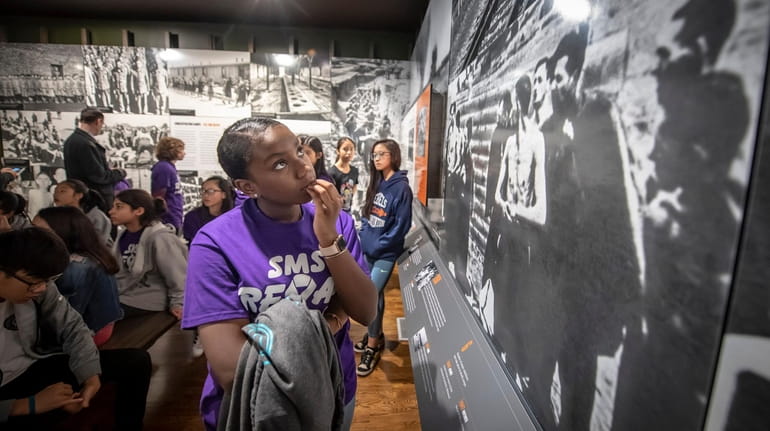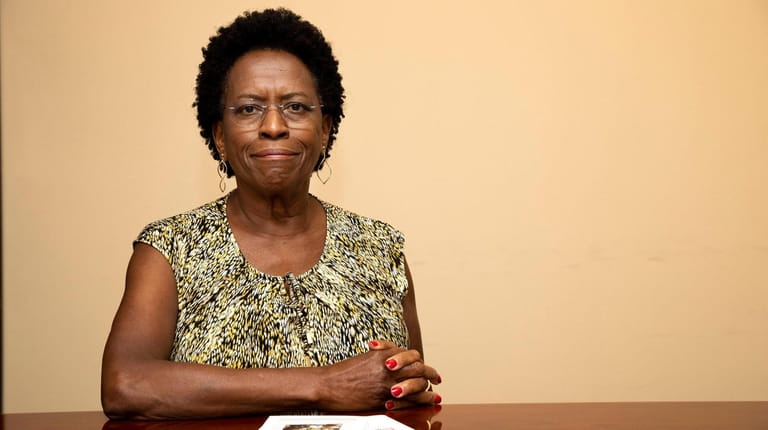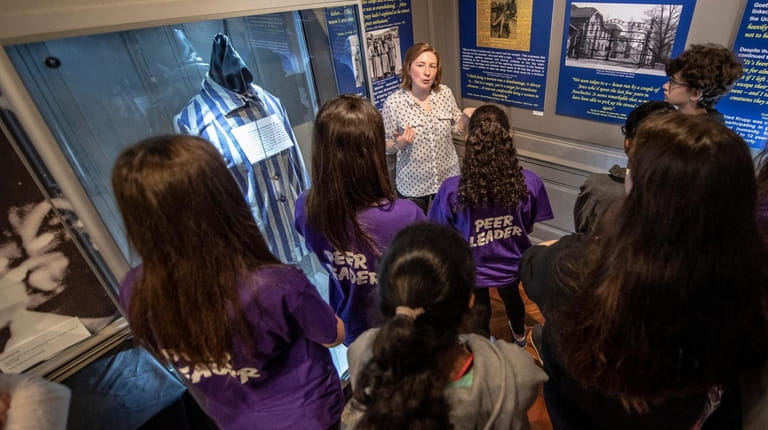Long Island groups push to end hate, divisive speech

Great Neck South Middle School student Kenelia Phillip, 13, looks at an exhibit at the Holocaust Memorial and Tolerance Center of Nassau County in Glen Cove on Friday. Credit: Newsday/J. Conrad Williams Jr.
The white swastika and racial slur painted on two Rockville Centre trees were removed right away. But the incident last year left an indelible mark on Rena Riback, a feeling that people needed to come together.
For her, the racist graffiti on Brower Avenue mirrored the rise in hate speech and intolerance throughout the nation.
Riback reached out to others in the community, and this fall they began holding meetings where people speak openly about the hate, racism and anti-Semitism they see — and what they can do about it.
The Anti-Racism Project, as it is called, is among a growing number of Long Island groups and individuals pushing to change a national discourse on race, ethnicity, religion, sexual orientation and gender identity that they see as divisive and destructive.
"People are overwhelmed by the hatred in our society," Riback said. "It's become normalized."
Not all of these efforts are brand-new, but those involved say violent events in the past few weeks have amped up their sense of urgency: A gunman who authorities say harbored anti-Semitic feelings killed 11 worshippers in a Pittsburgh synagogue, two African-Americans were gunned down in a Kentucky supermarket and a spate of pipe bombs were sent to prominent Democrats and other public figures.
Community leaders acknowledge that fostering such discussion will be a challenge, including on Long Island, which experts say has seen segregation and intolerance even as it’s become more diverse. Moreover, the charged rhetoric has been polarizing, with many groups hunkering down in their own corner.
Riback’s group and many others are determined to promote tolerance and understanding.
Showing solidarity against hate
When Rabbi Howard Buechler heard that a gunman shot his way through the Tree of Life synagogue in Pittsburgh last month, he knew people here would need a place to gather. To find peace and solace. And to take a stand.
He reached out to other rabbis, churches and neighborhood groups and within a few days held a rally that gathered some 2,000 people to his Dix Hills Jewish Center on Monday.
People there lighted candles, said prayers and called for love and peace to triumph over hate.
"The role of good people after such terrible events is to show solidarity," Buechler said.
Standing together
Malik Nadeem Abid, head of the New York chapter of American Muslim Voice, addressed Congregation Shaaray Shalom in West Hempstead last Sunday to say the Muslim community stood with them after the killings in Pittsburgh.
The next day, Abid, 55, joined community leaders to discuss security in local schools with the Nassau County district attorney's office.
Abid’s group has stepped up efforts to work with the community, he said.
Abid said President Donald Trump’s policies and rhetoric have frightened the immigrant community.
"It's fear of tomorrow. You don't know what's going to be happening," said Abid, of Valley Stream.
Trump has placed the blame elsewhere.
"A very big part of the Anger we see today in our society is caused by the purposely false and inaccurate reporting of the Mainstream Media that I refer to as Fake News,” he tweeted on Oct. 25.
Starting the conversation

Elaine Gross, seen here in Syosset on Thursday, Aug. 9, 2018, is president of ERASE Racism. Credit: Michael Owens
Elaine Gross wants to bring people of different colors and faiths together.
Beginning this month, Gross' group ERASE Racism, working with other civil rights groups, is sponsoring a series of five "community conversations" across Long Island. The first is Nov. 29 in Stony Brook.
"People are hearing all kinds of myths and misinformation about people not like them," Gross said.
Last Sunday, Pastor David Anglin spoke to his Amityville congregation at St. Paul’s Lutheran Church about the difference between politics and faith. He said he saw divisiveness on all sides of the political spectrum.
“What I sense is that people approach their politics the way people used to approach religion — that it’s unquestionable dogma,” he said, recalling his sermon. “Anyone who opposes you is not just an opponent, but an enemy.”
A changing Island
The face of Long Island has changed dramatically over the past several decades. In 1960, about 96 percent of the Island’s population was white, according to the U.S. Census. In 2017, about 74 percent identified as white and 63.5 percent identified as white non-Hispanic.
Minority groups began moving to the suburbs in search of better schools, easier homeownership and overall better quality of life, said Lawrence Levy, executive dean at the National Center for Suburban Studies at Hofstra University.
Between 2010 and 2017, the Latino or Hispanic population grew more than 18 percent, and the number of African-American residents increased about 8 percent.
“Any time there is rapid change, some people, usually those who were in power or were the dominant group, are going to be disturbed,” Levy said.
Signs of intolerance
Steven Markowitz said he's seen that lack of acceptance in Great Neck, where he's lived for 43 years. The community has seen an influx of various groups, including large Iranian and Asian populations.
“There’s concern about how we bring all these disparate groups together,” said Markowitz, who is chairman of the Holocaust Memorial and Tolerance Center of Nassau County.
The center has educational programs that emphasize the dangers of anti-Semitism, racism, bullying and intolerance. Some 17,000 students, most from Long Island schools, toured the center over the past year, Markowitz said.
The Anti-Defamation League said there was a 57 percent rise nationally in anti-Semitic incidents in 2017 from a year earlier, including a string of bomb threats, many of which were allegedly perpetrated by a Jewish teenager in Israel.
Within the LGBT community, the number of hate or bias incidents reported on Long Island more than doubled to 138 incidents in the first seven months of 2018, compared with the same period last year, according to the LGBT Network, based in Woodbury.
Many hate-inspired incidents never appear in police reports, as many groups, especially immigrants, are wary of reaching out to the police, advocates say. In addition, not all incidents necessarily classify as hate crimes, according to experts.
In Suffolk, 15 hate crime incidents were recorded this year through the end of September. Last year overall, 36 were reported, down from 42 in 2016.
Nassau police recorded 24 bias crimes and incidents in 2018 as of Oct. 29. The department reported 56 in 2017 and 59 in 2016.
Police say they continue to increase efforts to reach out to different community groups across the Island. Suffolk County recently hired a civilian liaison to help with its outreach to Latino residents. Earlier this year, Nassau County created the Commissioner’s Community Council to improve dialogue between police and the community.
“Every victim should always feel comfortable that they’re coming to police,” said Nassau County Police Commissioner Patrick Ryder.
Looking to the future

Helen Turner leads a group of students on a tour at the Holocaust Memorial and Tolerance Center of Nassau County in Glen Cove on Friday, Nov. 2, 2018. Credit: Newsday/J. Conrad Williams Jr.
Maybe the children will lead the way.
On Friday, a group of students from Great Neck South Middle School visited the Holocaust center in Glen Cove. They stood and stared at a concentration camp uniform, striped in faded blue and gray, and a tattered yellow Star of David made of cloth, which Jews were forced to wear in Germany and elsewhere in Europe before and during World War II.
"We talk about race in this building, but there’s only one race,” volunteer educator Ilise Friedman said. “Do you know what it is?”
“The human race,” said a few girls in the back of the group.
Kenelia Phillip, 13, reflected on her own life.
“People may think because I’m African American that I’m different,” she said. “But it doesn’t mean I’m not a regular person.”
The experience made Sarah Hao, 12, think about how lucky she was. And the dangers of stereotypes.
“I think we should accept everyone as they are,” she said. “Not how they look or what religion they are.”
With Janelle Griffith and Sabrina Escobar

